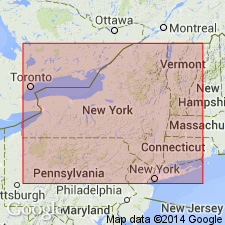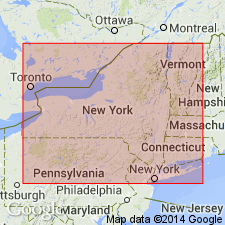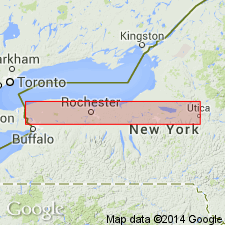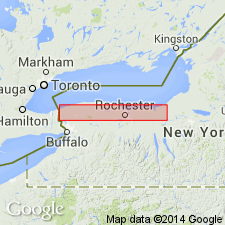
- Usage in publication:
-
- Bear Creek shale
- Modifications:
-
- Original reference
- Dominant lithology:
-
- Shale
- AAPG geologic province:
-
- Appalachian basin
Summary:
Pg. 327-386. Bear Creek shale. Fossiliferous shale just beneath Furnaceville ore at old "Wolcott ore bed" on Bear Creek (Black Creek on topographic map), [Wayne County, central New York]. If distinct from the Martville [sandstone], the Bear Creek shale will lie above rather than below it. [Belongs in the lower part of Clinton formation. Age is Silurian.]
Source: US geologic names lexicon (USGS Bull. 896, p. 132).

- Usage in publication:
-
- Bear Creek shale
- Modifications:
-
- Revised
- AAPG geologic province:
-
- Appalachian basin
Summary:
Author placed the Bear Creek shale below the Sterling Station ore and above the Reynales limestone, and included the Furnaceville ore in the Reynales. The Bear Creek shale is described in the Rochester section as consisting of 18 feet of purple and olive shales with thin plates of fossiliferous limestone.
Source: GNU records (USGS DDS-6; Reston GNULEX).

- Usage in publication:
-
- Bear Creek shale
- Modifications:
-
- Revised
- Redescribed
- AAPG geologic province:
-
- Appalachian basin
Summary:
Chadwick used term Bear Creek to designate dark pelecypod-bearing shales which were supposed to underlie the Furnaceville in the town of Wolcott. However, no such shale exists beneath the Furnaceville, but there is a shale above the ore which contains the fauna. The Bear Creek is here revised to apply to pelecypod-bearing shales and argillaceous facies of Reynales limestone. At the type locality, unit is a dark-gray thin-bedded silty slightly calcareous shale with argillaceous limestone layers; both shales and limestones are pyritic. Lower 7 feet are about half shale and half argillaceous limestone; next 6 feet are mostly shale. Top of formation is marked by an 8 inch limestone layer which in turn is overlain by 3 inches of hematitic limestone. Unit underlies the Sodus shale.
Source: GNU records (USGS DDS-6; Reston GNULEX).

- Usage in publication:
-
- Bear Creek Shale
- Modifications:
-
- Areal extent
- AAPG geologic province:
-
- Appalachian basin
Summary:
Greenish gray shales of the Wallington Member of the Reynales Limestone thicken westward, until at Bear Creek, in eastern Wayne Co., the unit has become more than half shale and is referred to as the Bear Creek Shale. The Reynales and Bear Creek are capped by the Sterling Station Bed, a thin oolitic hematite. Overlies the Furnaceville Member of the Reynales and underlies the Sodus Shale.
Source: GNU records (USGS DDS-6; Reston GNULEX).
For more information, please contact Nancy Stamm, Geologic Names Committee Secretary.
Asterisk (*) indicates published by U.S. Geological Survey authors.
"No current usage" (†) implies that a name has been abandoned or has fallen into disuse. Former usage and, if known, replacement name given in parentheses ( ).
Slash (/) indicates name conflicts with nomenclatural guidelines (CSN, 1933; ACSN, 1961, 1970; NACSN, 1983, 2005, 2021). May be explained within brackets ([ ]).

